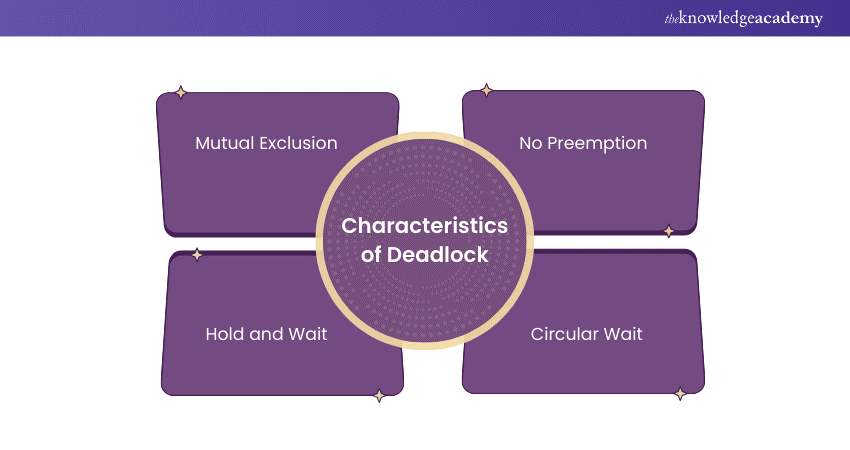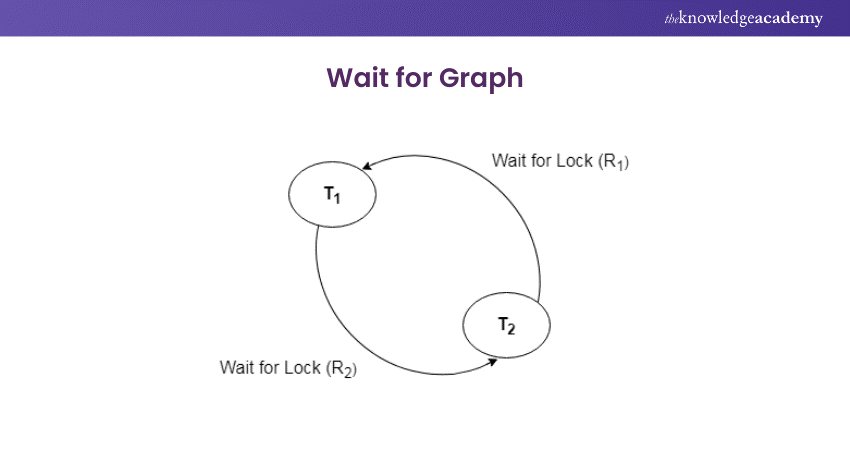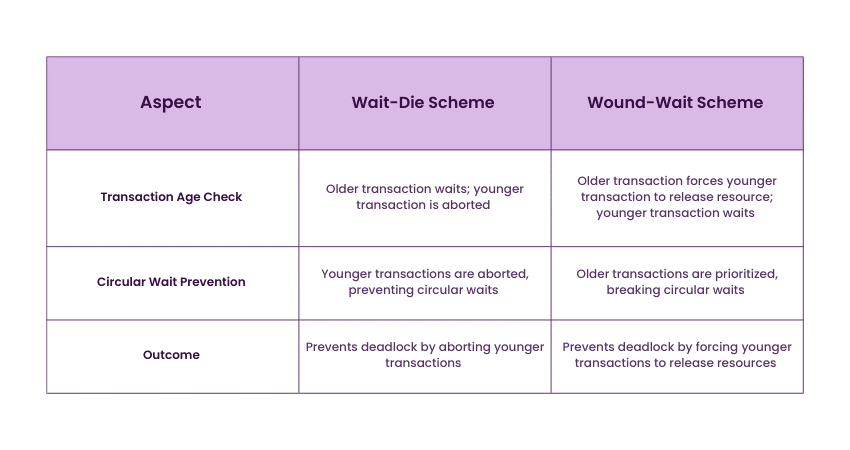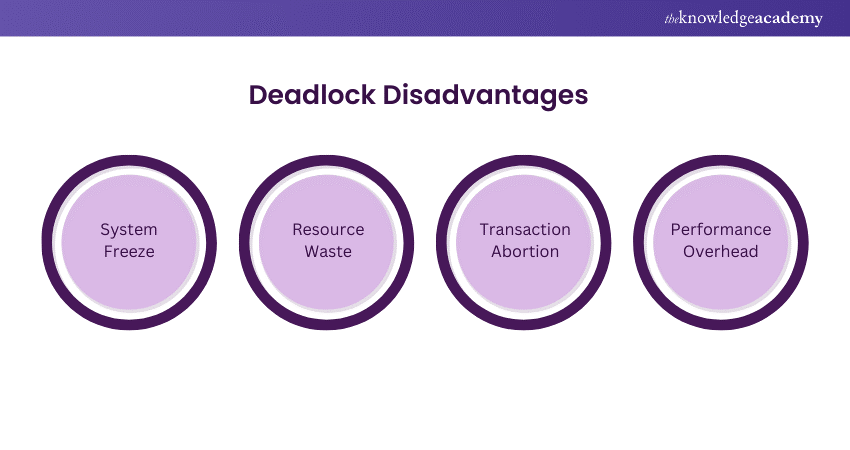We may not have the course you’re looking for. If you enquire or give us a call on +33 805638382 and speak to our training experts, we may still be able to help with your training requirements.
Training Outcomes Within Your Budget!
We ensure quality, budget-alignment, and timely delivery by our expert instructors.

Deadlock in a Database Management System (DBMS) can feel like a system gridlock - where nothing moves forward. Deadlock in DBMS is a tricky problem that arises when multiple transactions block each other, leaving the database frozen. This results in a standstill, preventing the database from processing any further actions.
Understanding Deadlock is crucial for Database Administrators and Developers alike to ensure smooth, efficient operations. This blog breaks down the concept of Deadlock in DBMS, explores its causes, and explains methods to prevent and resolve Deadlocks, helping you keep your database running seamlessly.
Table of Contents
1) What is Deadlock in DBMS?
2) Deadlock Avoidance
3) Deadlock Detection
4) Deadlock Prevention
5) Deadlock Disadvantage
6) Conclusion
What is Deadlock in DBMS?
A Deadlock in a DBMS refers to the situation in which two or more transactions are in a state such that none of them can proceed because each of them is waiting for the other to release some resource.
Imagine a scenario where Transaction A is holding Resource 1 and waiting for Resource 2, while Transaction B is holding Resource 2 and waiting for Resource 1. Neither can proceed until the other releases a resource, leading to a system standstill—this is a Deadlock.
Deadlock primarily arises in multi-transactional systems where multiple processes are running concurrently. It's not necessarily common but can be devastating when it happens, freezing the entire system and requiring significant effort to resolve.
Characteristics of Deadlock
To have effective Deadlock detection and management, there is a need to identify the major characteristics of Deadlocks. In the DBMS world, Deadlock occurs only when four conditions are met simultaneously:

1) Mutual Exclusion: There must be at least one resource that is in a non-shareable mode. Thus, only one transaction can access the resource at one time.
2) Hold and Wait: A transaction is holding one resource and waiting for other resources held by other transactions.
3) No Preemption: A resource could not be removed from a transaction forcefully that is holding it. System must wait until the transaction releases it voluntarily.
4) Circular Wait: Circular wait for transactions always exists. Here, each transaction holds a resource on which the next one needs to hold. A waits for B, B waits for C, and so on, until a transaction waits on A.
Deadlock Avoidance
Stopping Deadlocks before they occur is often better than recovering from them. Deadlock avoidance is an example of careful resource allocation. The DBMS checks whether granting a resource to a transaction will potentially lead to a Deadlock. If it predicts a Deadlock, it denies the request, making the system safe.
Another method for preventing Deadlock is Banker's Algorithm, which checks whether resources can be allocated safely so that no Deadlock will occur. For the sake of practical implementation, Deadlock avoidance may involve transactions to make decisions that guarantee no circular wait conditions.
However, Deadlock avoidance may degrade the performance of the system since the algorithms running for continuous monitoring and forecasting possible Deadlocks incur computational overhead.
Deadlock Detection
If Deadlocks are not avoided, they must be detected; hence, Deadlock detection techniques periodically check for Deadlock conditions and resolve these by aborting one or more transactions involved.
The DBMS may employ Deadlock detection algorithms to look for cycles in the resource allocation graph. If any cycle is detected, it implies a Deadlock, and the system might abort one of the transactions to break the cycle.
Wait for Graph

The Wait-for Graph is a very simple tool used for Deadlock detection. In the graph, every node represents a transaction. Now, an edge from Transaction A to Transaction B means that A is waiting for a resource being held by B.
If a cycle is in the graph, then there is Deadlock. To clean this out, either one or more of the transactions in the cycle need to be aborted so that the Deadlock is broken for the others to go.
Build a solid foundation in Database Management with our Introduction to Database Training - Start learning today!
Deadlock Prevention
Deadlock prevention techniques change the way resources are allocated such that at least one of the necessary conditions for Deadlock cannot occur.
Prevention, unlike avoidance, does not rely on predicting a Deadlock but rather prevents Deadlock from happening in the first place by managing resource requests. Two prominent Deadlock prevention schemes are:

Wait-Die Scheme
In the Wait-Die Scheme, when a transaction requests a resource that is currently held by another transaction, the system checks the timestamp of both transactions. If the requesting transaction is older (has a smaller timestamp), it can wait.
If it is younger, the transaction is aborted, effectively "dying." By forcing younger transactions to give up their resources, the system prevents circular waits from occurring, thereby preventing Deadlocks.
Wound Wait Scheme
The Wound-Wait Scheme works in the opposite way. When a transaction requests a resource held by another transaction, if the requesting transaction is older, it forces the younger transaction to release the resource, or "wound" it.
If the requesting transaction is younger, it waits. This approach also eliminates the possibility of a circular wait by ensuring that older transactions are prioritised and younger transactions either wait or are aborted.
Deadlock Disadvantages
There are several issues that concern the efficiency of a DBMS in handling Deadlocks. Some of the major disadvantages of Deadlock are:

1) System Freeze: A Deadlock freezes the system and consequently freezes all the transactions, so none of them can make any further progress.
2) Resource Waste: In case of a Deadlock, resources held by a transaction are not available to other processes; this is an inefficient way of utilising resources.
3) Transaction Abortion: The resolution of a Deadlock usually involves the abortion of one or more transactions, which wastes some computation and restarting processes.
4) Performance Overhead: Deadlock prevention, detection, and resolution incur some extra computational overhead, slowing the overall system performance.
Expand your knowledge and expertise on database approaches and DBMS with our Relational Databases & Data Modelling Training - Register now!
Conclusion
Deadlock in DBMS can severely impact system performance by freezing transactions and wasting resources. However, you can effectively manage these situations by understanding and applying the right techniques for avoidance, detection, and prevention. We hope that by following this blog's insights, you are better equipped to handle Deadlocks and maintain optimal performance in your DBMS environments.
Unlock the power of GraphQL! Master database queries like never before. Join our GraphQL Database Training and advance your skills today!
Frequently Asked Questions

Resource allocation can avoid Deadlock. Techniques like Banker's Algorithm predict Deadlock by evaluating transactions before granting resources. If the system detects a possible Deadlock, then it denies the allocation of resources, thus avoiding Deadlock.

Four conditions for Deadlock in DBMS are: mutual exclusion; hold and wait; no pre-emption; and circular wait. For a Deadlock to occur, there must be simultaneous existing of all these conditions. Resources dependency results in the Deadlock halting transaction. If one condition is prevented, Deadlock is prevented.

The Knowledge Academy takes global learning to new heights, offering over 30,000 online courses across 490+ locations in 220 countries. This expansive reach ensures accessibility and convenience for learners worldwide.
Alongside our diverse Online Course Catalogue, encompassing 19 major categories, we go the extra mile by providing a plethora of free educational Online Resources like News updates, Blogs, videos, webinars, and interview questions. Tailoring learning experiences further, professionals can maximise value with customisable Course Bundles of TKA.

The Knowledge Academy’s Knowledge Pass, a prepaid voucher, adds another layer of flexibility, allowing course bookings over a 12-month period. Join us on a journey where education knows no bounds.

The Knowledge Academy offers various Database Courses, including the Influx DB Course and the Introduction to Database Course. These courses cater to different skill levels, providing comprehensive insights into What is DBMS.
Our Programming & DevOps Blogs cover a range of topics related to DBMS, offering valuable resources, best practices, and industry insights. Whether you are a beginner or looking to advance your DBMS skills, The Knowledge Academy's diverse courses and informative blogs have got you covered.
Upcoming Programming & DevOps Resources Batches & Dates
Date
 Introduction to Database Training
Introduction to Database Training
Fri 21st Feb 2025
Fri 25th Apr 2025
Fri 20th Jun 2025
Fri 22nd Aug 2025
Fri 17th Oct 2025
Fri 19th Dec 2025







 Top Rated Course
Top Rated Course



 If you wish to make any changes to your course, please
If you wish to make any changes to your course, please


